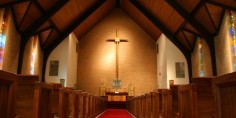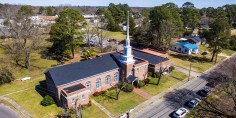This article is part of our Reimagining Church Real Estate series that explores how the Endowment’s Rural Church grantee partners are embracing adaptive reuse of church properties.
In 2019, when the Rev. Lynda Ferguson was asked how her Asheboro, North Carolina, church might reuse an available empty building, the answer was immediately clear.
“I instantly said a homeless shelter for women and children,” Ferguson recalled. “There was not one in Randolph County, and many women and children had come to the church, or I had met them on the street. God kept putting them in my path.”
The question arose when Rev. Ferguson was touring the former Calvary United Methodist Church with Joel Gilland, president and CEO of Wesley Community Development (Wesley CDC), which manages unused church properties for the two United Methodist Church (UMC) conferences in North Carolina. A once-thriving church, Calvary closed in 2018, and Gilland invited Ferguson, senior pastor at First United Methodist Church Asheboro, to walk through the vacant sanctuary and education buildings and consider creative ways to use those spaces for another purpose.
As church attendance has shifted over the past few decades, church leaders are also shifting their ideas about what ministry can look like. Beyond Sunday services and Wednesday night suppers, most church buildings remain unused roughly 90 percent of the time. For Ferguson and Gilland, reusing and repurposing makes sense financially and spiritually.
“The United Methodist Church in North Carolina has great assets,” Gilland said. “Rather than lose them, we want to deploy them back into ministry.”
The Origins of Lydia’s Place
In 2019, the Western North Carolina UMC Conference transferred the deed for the former Calvary property to First UMC Asheboro, which then created Lydia’s Place, an independent nonprofit transitional shelter for women and children. Lydia’s Place leases the property from First UMC Asheboro for $1 per year.
Repurposing the church property was no small undertaking. There were several construction hurdles and expenses, starting with a renovation of the fellowship hall to hold 12 beds, showers, laundry and a kitchen before transitioning the education building into suitable living space for an additional 38 residents. Lydia’s Place also offers much more than shelter. In addition to providing food and necessities, case workers at the shelter connect women and their families with education, employment, public benefits, transportation, addiction recovery services and more. This monumental effort requires an enormous amount of coordination and partnership – far beyond the capacity of First UMC Asheboro alone.
A Caring Community Aligned
Leaders of First UMC Asheboro immediately embraced the idea of creating the shelter and recognized the need to foster broader community support for the undertaking. Rev. Ferguson shared the invitation for others to join the project and the mission, reaching out to many nonprofits and churches in Randolph County. Early, smaller meetings at Calvary focused on visioning, eventually growing into a larger community meeting at First UMC Asheboro to present the proposal for Lydia’s Place and get feedback.
“One of the beautiful things was that people came together across all theological spectrums and united around the call of serving the homeless population of women and children,” Rev. Ferguson noted.
Pastor Ferguson and her team also took care to acknowledge the contributions of the past. “We were intentional about involving the former members of Calvary in this project to honor the ministry that was. We really consider this a resurrection story.”
“I was a member of Calvary for 65 years, and it broke my heart when it closed,” remembered congregant Nancy York. “But it still feels like this church is part of God’s work.”
Relationships Secure Sustainability
Renovations to create Lydia’s Place cost roughly $1.4 million over a span of about three years. The Duke Endowment supported the first two phases of development with a $775,000 grant, serving as a catalyst for other contributors.
Rev. Ferguson and church elders reached out to city and county leaders as well as their state representatives to cultivate additional funding. County commissioners were primed to help address the problem after a study revealed an unexpectedly high number of homeless children.
“Lydia’s Place board member Janice Kite invited me to be part of the initial planning,” County Commissioner Hope Haywood recalled. “Being there to hear about the process and the obstacles they were facing was valuable, and I encouraged them to apply for county funding.”
Haywood also noted that having The Duke Endowment on board added a layer of credibility to the project. “We know they are going to vet a project thoroughly before they invest in it and will look for outcomes. If they’re going to fund it, then we feel comfortable providing some funding as well.”
Since first opening in August 2022, Lydia’s Place now receives broad financial support for its annual operations from local, county and state government, area churches, businesses, individual donations and foundation grants. Nonprofits and churches across the county partner with First UMC Asheboro to provide meals and services to residents of Lydia’s Place, with more than 300 volunteers providing countless hours of support and encouragement. “It’s amazing how the residents, church members and others have joined together to support this community,” Rev. Ferguson said.
By the end of 2024, Lydia’s Place provided shelter for 16 families, housing 31 children and 37 individuals with an average stay of six months. Of those, seven families and four individuals transitioned into permanent housing with support from a Lydia’s Place caseworker. In addition, 15 residents found employment, 12 entered addiction recovery and three completed a GED.
Lydia’s Place is now renovating a former parsonage at another closed church to provide affordable rental housing for families who are ready to move out of the shelter and into a more self-sufficient life.
Dream Big and Have Courage
A large building reuse project like Lydia’s Place may seem out of reach for some, but Rev. Ferguson encourages other United Methodist churches to explore the possibilities.
“The main thing is to dream big, have courage, and not be afraid,” she says. “Allow God to lead the project and trust that God’s going to create the relationships and all the things that need to happen.”



